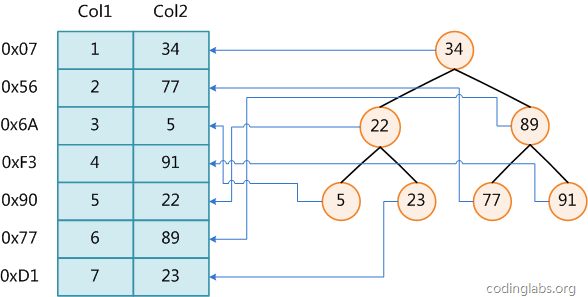MySQL 查詢(xún)的排序、分頁(yè)相關(guān)
概述
數(shù)據(jù)庫(kù)中的數(shù)據(jù)直接呈現(xiàn)出來(lái)一般不是我們想要的,所以我們上兩節(jié)演示了如何對(duì)數(shù)據(jù)進(jìn)行過(guò)濾的方法。除了對(duì)數(shù)據(jù)進(jìn)行過(guò)濾,
我們可能還需要對(duì)數(shù)據(jù)進(jìn)行排序,比如想從列表中了解消費(fèi)最高的項(xiàng),就可能需要對(duì)金額字段做降序排序,想看年齡從小到大的分布情況,就可能需要對(duì)user表的age字段進(jìn)行升序排序。
也可能需要對(duì)數(shù)據(jù)進(jìn)行限制,比如我們需要對(duì)付款的1~10,11~20,21~30 名的用戶分別贈(zèng)予不同的禮品,這時(shí)候?qū)?shù)據(jù)的限制就很有用了。
備注:下面腳本中[]包含的表示可選,| 分隔符表示可選其一。
數(shù)據(jù)排序 order by
語(yǔ)法格式如下:
1、需要排序的字段跟在order by之后;
2、asc 和 desc表示排序的規(guī)則,asc:升序,desc:降序,默認(rèn)為升序 asc;
3、排序可以指定多次字段,多字段排序之間用逗號(hào)隔開(kāi)。
4、多字段排序中,越靠前優(yōu)先級(jí)越高,下面中cname1優(yōu)先排序,當(dāng)cname1等值的時(shí)候,cname2開(kāi)始排序,直至所有字段都排序完。
select cname from tname order by cname1 [asc|desc],cname2 [asc|desc]...;
單個(gè)字段排序
舉個(gè)例子,在銷(xiāo)售額中通按照交易的訂單進(jìn)行金額額度降序的方式顯示:
mysql> select * from t_order;+---------+---------+---------+-------+| orderid | account | amount | goods |+---------+---------+---------+-------+| 8 | brand | 52.2 | 2 || 9 | hen | 1752.02 | 7 || 10 | helyn | 88.5 | 4 || 11 | sol | 1007.9 | 11 || 12 | diny | 12 | 1 || 13 | weng | 52.2 | 5 || 14 | sally | 99.71 | 9 |+---------+---------+---------+-------+7 rows in setmysql> select * from t_order order by amount desc;+---------+---------+---------+-------+| orderid | account | amount | goods |+---------+---------+---------+-------+| 9 | hen | 1752.02 | 7 || 11 | sol | 1007.9 | 11 || 14 | sally | 99.71 | 9 || 10 | helyn | 88.5 | 4 || 8 | brand | 52.2 | 2 || 13 | weng | 52.2 | 5 || 12 | diny | 12 | 1 |+---------+---------+---------+-------+7 rows in set
多個(gè)字段排序
多個(gè)字段排序用逗號(hào)隔開(kāi),優(yōu)先級(jí)從左到右逐次遞減,如下圖,如果金額一致,則按照購(gòu)買(mǎi)商品數(shù)量從多到少排序:
mysql> select * from t_order order by amount desc,goods desc;+---------+---------+---------+-------+| orderid | account | amount | goods |+---------+---------+---------+-------+| 9 | hen | 1752.02 | 7 || 11 | sol | 1007.9 | 11 || 14 | sally | 99.71 | 9 || 10 | helyn | 88.5 | 4 || 13 | weng | 52.2 | 5 || 8 | brand | 52.2 | 2 || 12 | diny | 12 | 1 |+---------+---------+---------+-------+7 rows in set
按alias排序
按照別名排序或者做條件查詢(xún)的目的都是為了簡(jiǎn)化代碼,方便使用,別名可以是英文,也可以是中文:
mysql> select account as ac,amount as am,goods as gd from t_order order by am,gd desc;+-------+---------+----+| ac | am | gd |+-------+---------+----+| diny | 12 | 1 || weng | 52.2 | 5 || brand | 52.2 | 2 || helyn | 88.5 | 4 || sally | 99.71 | 9 || sol | 1007.9 | 11 || hen | 1752.02 | 7 |+-------+---------+----+7 rows in set
字段排序中使用函數(shù)
下面使用了abs取絕對(duì)值函數(shù),所以在 am字段降序排序中,-99.99 排在 99.71之上。
mysql> select * from t_order;+---------+---------+---------+-------+| orderid | account | amount | goods |+---------+---------+---------+-------+| 8 | brand | 52.2 | 2 || 9 | hen | 1752.02 | 7 || 10 | helyn | 88.5 | 4 || 11 | sol | 1007.9 | 11 || 12 | diny | 12 | 1 || 13 | weng | 52.2 | 5 || 14 | sally | 99.71 | 9 || 15 | brand1 | -99.99 | 5 |+---------+---------+---------+-------+8 rows in setmysql> select account as ac,amount as am,goods as gd from t_order order by abs(am) desc;+--------+---------+----+| ac | am | gd |+--------+---------+----+| hen | 1752.02 | 7 || sol | 1007.9 | 11 || brand1 | -99.99 | 5 || sally | 99.71 | 9 || helyn | 88.5 | 4 || brand | 52.2 | 2 || weng | 52.2 | 5 || diny | 12 | 1 |+--------+---------+----+8 rows in set
與Where條件結(jié)合使用
order 在 where 條件之后,根據(jù)where已經(jīng)過(guò)濾好的數(shù)據(jù)再進(jìn)行排序。下面是過(guò)濾出購(gòu)買(mǎi)金額>80 且 購(gòu)買(mǎi)數(shù)量>5的數(shù)據(jù),并且按照價(jià)格降序排序。
mysql> select * from t_order;+---------+---------+---------+-------+| orderid | account | amount | goods |+---------+---------+---------+-------+| 8 | brand | 52.2 | 2 || 9 | hen | 1752.02 | 7 || 10 | helyn | 88.5 | 4 || 11 | sol | 1007.9 | 11 || 12 | diny | 12 | 1 || 13 | weng | 52.2 | 5 || 14 | sally | 99.71 | 9 || 15 | brand1 | -99.99 | 5 |+---------+---------+---------+-------+8 rows in setmysql> select * from t_order where amount>80 and goods>5 order by amount desc;+---------+---------+---------+-------+| orderid | account | amount | goods |+---------+---------+---------+-------+| 9 | hen | 1752.02 | 7 || 11 | sol | 1007.9 | 11 || 14 | sally | 99.71 | 9 |+---------+---------+---------+-------+
數(shù)據(jù)limit
很多時(shí)候我們過(guò)濾出符合要求的數(shù)據(jù)之后,還需要得到這些數(shù)據(jù)中的某一個(gè)具體區(qū)間,比如對(duì)付款超過(guò)1000的用戶的第1~10,11~20,21~30 名分別贈(zèng)予不同的禮品,這時(shí)候就要使用limit操作了。
limit用來(lái)限制select查詢(xún)返回的數(shù)據(jù),常用于數(shù)據(jù)排行或者分頁(yè)等情況。
語(yǔ)法格式如下:
select cname from tname limit [offset,] count;
1、offset表示偏移量,就是指跳過(guò)的行數(shù),可以省略不寫(xiě),默認(rèn)為0,表示跳過(guò)0行,如 limit 8 等同于 limit 0,8。
2、count:跳過(guò)偏移量offset之后開(kāi)始取的數(shù)據(jù)行數(shù),有count行。
3、limit中offset和count的值不能用表達(dá)式。
獲取前n條記錄
如下圖,limit n 和 limit 0,n 是一致的:
mysql> select * from t_order;+---------+---------+---------+-------+| orderid | account | amount | goods |+---------+---------+---------+-------+| 8 | brand | 52.2 | 2 || 9 | hen | 1752.02 | 7 || 10 | helyn | 88.5 | 4 || 11 | sol | 1007.9 | 11 || 12 | diny | 12 | 1 || 13 | weng | 52.2 | 5 || 14 | sally | 99.71 | 9 || 15 | brand1 | -99.99 | 5 |+---------+---------+---------+-------+8 rows in setmysql> select * from t_order limit 2;+---------+---------+---------+-------+| orderid | account | amount | goods |+---------+---------+---------+-------+| 8 | brand | 52.2 | 2 || 9 | hen | 1752.02 | 7 |+---------+---------+---------+-------+2 rows in setmysql> select * from t_order limit 0,2;+---------+---------+---------+-------+| orderid | account | amount | goods |+---------+---------+---------+-------+| 8 | brand | 52.2 | 2 || 9 | hen | 1752.02 | 7 |+---------+---------+---------+-------+2 rows in set
limit限制單條記錄
這邊我們獲取支付金額中最大和最小的的一條記錄。可以先使用 order 條件進(jìn)行排序,然后limit 第1條記錄即可:
mysql> select * from t_order; +---------+---------+---------+-------+ | orderid | account | amount | goods | +---------+---------+---------+-------+ | 8 | brand | 52.2 | 2 | | 9 | hen | 1752.02 | 7 | | 10 | helyn | 88.5 | 4 | | 11 | sol | 1007.9 | 11 | | 12 | diny | 12 | 1 | | 13 | weng | 52.2 | 5 | | 14 | sally | 99.71 | 9 | | 15 | brand1 | -99.99 | 5 | +---------+---------+---------+-------+ 8 rows in set mysql> select * from t_order where amount>0 order by amount desc limit 1; +---------+---------+---------+-------+ | orderid | account | amount | goods | +---------+---------+---------+-------+ | 9 | hen | 1752.02 | 7 | +---------+---------+---------+-------+ 1 row in set mysql> select * from t_order where amount>0 order by amount asc limit 1; +---------+---------+--------+-------+ | orderid | account | amount | goods | +---------+---------+--------+-------+ | 12 | diny | 12 | 1 | +---------+---------+--------+-------+ 1 row in set
以上就是MySQL 查詢(xún)的排序、分頁(yè)相關(guān)的詳細(xì)內(nèi)容,更多關(guān)于MySQL 查詢(xún)的資料請(qǐng)關(guān)注好吧啦網(wǎng)其它相關(guān)文章!
相關(guān)文章:
1. MySQL 如何設(shè)計(jì)統(tǒng)計(jì)數(shù)據(jù)表2. MySQL索引背后的數(shù)據(jù)結(jié)構(gòu)及算法原理3. 實(shí)例講解SQL Server中非常有用EXISTS結(jié)構(gòu)4. MySQL系列之三 基礎(chǔ)篇5. MySQL OOM(內(nèi)存溢出)的解決思路6. MySQL CHAR和VARCHAR該如何選擇7. SQL Server 數(shù)據(jù)庫(kù)的更改默認(rèn)備份目錄的詳細(xì)步驟8. SQL Server和Oracle數(shù)據(jù)鎖定比較9. Sql Server 壓縮數(shù)據(jù)庫(kù)日志文件的方法10. PyCharm MySQL可視化Database配置過(guò)程圖解

 網(wǎng)公網(wǎng)安備
網(wǎng)公網(wǎng)安備